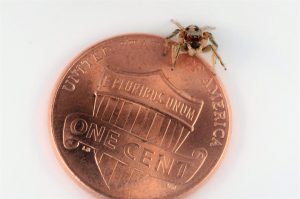Halloween decorations often include giant, fuzzy spiders leaping out at you from their webs. But what are jumping spiders really like? A University of Florida researcher shares why these fuzzy creatures are not so spooky after all.

“Jumping spiders in particular are the exact opposite of creepy spiders,” said Lisa Taylor, UF/Institute of Food and Agricultural Sciences research scientist and expert in spider behavior and ecology. “They are fuzzy, colorful and completely harmless. Most of them are even too small to bite you.”
“Unless you are a male spider and then you would have to worry about getting eaten by a female. I guess that is a bit spooky,” she said.
Jumping spiders are voracious predators, hungry for pests we dislike.
Jumping spiders are named after their jump attack strategy to capture prey. They eat anything that wanders by including fruit flies, mosquitoes and agricultural pests. They even eat cockroaches, but most jumping spiders are too small to take down a full-sized roach, so they stick to the smaller roaches.
“Anything you can think of that you don’t like, spiders like,” Taylor said. “They are pretty useful to have around.”
The gray wall jumper, a species found worldwide, prefers to cling to vertical surfaces such as trees and walls. This gives the spider a better view of bugs that land on the wall so they can attack them upon arrival.
The twin-flagged jumping spider, found in many backyards across the Southeastern U.S., is a generalist that will attack anything that moves, according to Taylor. This jumping spider prefers ants and has a special attack strategy that they utilize only when hunting ants where they attack the back of the neck so the ant cannot sting or attack them, making them very successful hunters.
“In short, the more spiders around, the less other bugs you will have around,” she said.
Spiders “sing and dance” for one another.

Many male jumping spiders participate in beauty displays for females that include singing and dancing. Their mission is to have the opportunity to mate instead of becoming dinner.
To create the sound, they tap and thump their legs and abdomen to the ground and scrape their abdomen and legs together. Songs vary among jumping spider species, however none of these sounds are detectable by the human ear without using a tool called a laser vibrometer. Female spiders detect the sounds with structures on their legs that “hear” the vibrations.
Male magnolia jumping spiders, commonly found on magnolia and oak trees across the Southeast U.S., demonstrate and show off their colors for other males. These displays include waving their arms and moving from side-to-side.
Spiders are not motivated to bite people.
When most people worry about spider bites, they worry about a black widow or brown recluse. However, most spider species are completely harmless, Taylor said. Their mouth parts are too small to penetrate human skin and their venom was not designed to interact with our systems. Typically, a spider bite hurts less than a bee sting.
“Aside from the very small handful of spider species worldwide that do occasionally, but rarely, bite people and produce a reaction (like black widows and brown recluses), the rest are completely harmless,” Taylor explained.
People often see two holes next to each other and assume it is a spider bite, but a lot of things that bite have two mouth parts that pinch. Usually bites blamed on spiders are from other insects that also have two mouth parts.
“I have handled thousands of spiders and I have never been bitten,” Taylor said. “They are not motivated to bite people.”
Stop and watch the spiders.
Spiders may seem creepy on the surface, but if you look closely, their behavior is quite interesting, Taylor said.
Take a closer look at jumping spiders. Look at their fuzzy face. With big eyes, people often find them to be more approachable than other types of spiders.
“Slow down to watch them and you may spot one eating a mosquito or see a male dancing for a female,” Taylor said. “You may just find them to be pretty neat.”
 0
0
